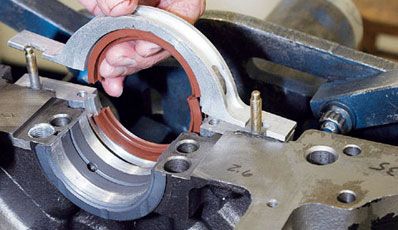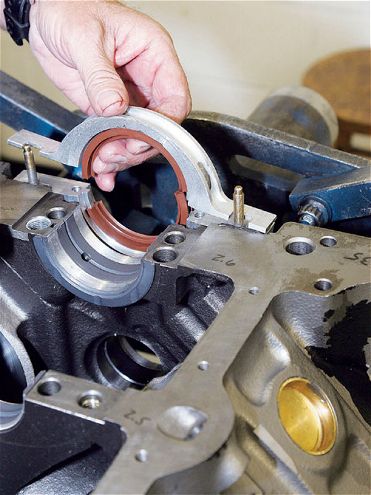
 Chevrolet converted its blocks to a one-piece rear main oil seal design beginning in 1986, but the stock car racing aftermarket has stuck with the crankshafts, oil pans, and other products that only work with the two-piece design. Thankfully, it's easy to install an adapter to convert your newer block to a two-piece design.
Chevrolet converted its blocks to a one-piece rear main oil seal design beginning in 1986, but the stock car racing aftermarket has stuck with the crankshafts, oil pans, and other products that only work with the two-piece design. Thankfully, it's easy to install an adapter to convert your newer block to a two-piece design.
There are several reasons that Chevrolet's V-8 engine package is so popular among racers and widely supported by the aftermarket. It is compact and relatively lightweight for its displacement. It has a dependable oiling system that holds up well to high-rpm abuse. It's comparatively easy to build and find ways to make power. And finally, the design has remained relatively unchanged since Chevrolet first debuted its 350ci V-8 in 1968. It wasn't phased out of production until 1996, when the LS family of engines took over.
Because of the stability of the engine's design, the Chevy V-8 for years could be easily found in junkyards (that's less true these days), and as a result the aftermarket supported the engine with all kinds of performance parts. Because there are so many performance options for this engine-everything from oil pans to intakes-manufacturers have to keep their prices down to stay competitive, and you can build a high-power Chevy race engine cheaper than just about any other engine with equivalent horsepower.
The one thing that throws a big, fat monkey wrench into the works is a design change to the rear main oil seal that Chevrolet's engineers made in '86 model year engines. Before that, the rear main oil seal had been a two-piece design. The problem with the two-piece seal is that it can sometimes allow oil to seep out. This really is only a problem when the engine is built on an assembly line; when a knowledgeable engine builder assembles the oil seal by hand with the proper precautions, an oil leak is a rarity. Still, new models leaking oil onto the proud owner's garage floor isn't something car manufacturers want, so the oil seal was changed to a one-piece design.
The one-piece oil seal design never caught on among racers. It made working on the engine slightly more complicated and required a different design for the crank, block, and oil pan. This wasn't a problem when junkyard blocks from older models were still plentiful and GM Performance Parts still sold new blocks with the old seal design.
That has all changed, however. GM recently sold the last of its block inventory with the two-piece design, and there are no plans to cast any more. The aftermarket, such as Dart or Motown, still produces small-block castings with the two-piece rear main seal design, but they tend to be more expensive than the stock blocks GM sells. Thankfully, it's relatively easy to convert a block from a one-piece rear main seal design to the older two-piece style with an adapter. The adapter makes it work with popular aftermarket crankshafts, oil pans, and other components. No major machining operations need to be performed on the block to get the adapter to fit. In addition to the adapter plate-available from GM (PN 10051118), Canton (PN 21-850), and many other manufacturers-a small fixture to simulate crankshaft location is required when performing this conversion. Some engine builders, such as Keith Dorton of Automotive Specialists, who walked us through this installation process, produce their own with round stock on a lathe, but you can also purchase one from CV Products (PN CV925).